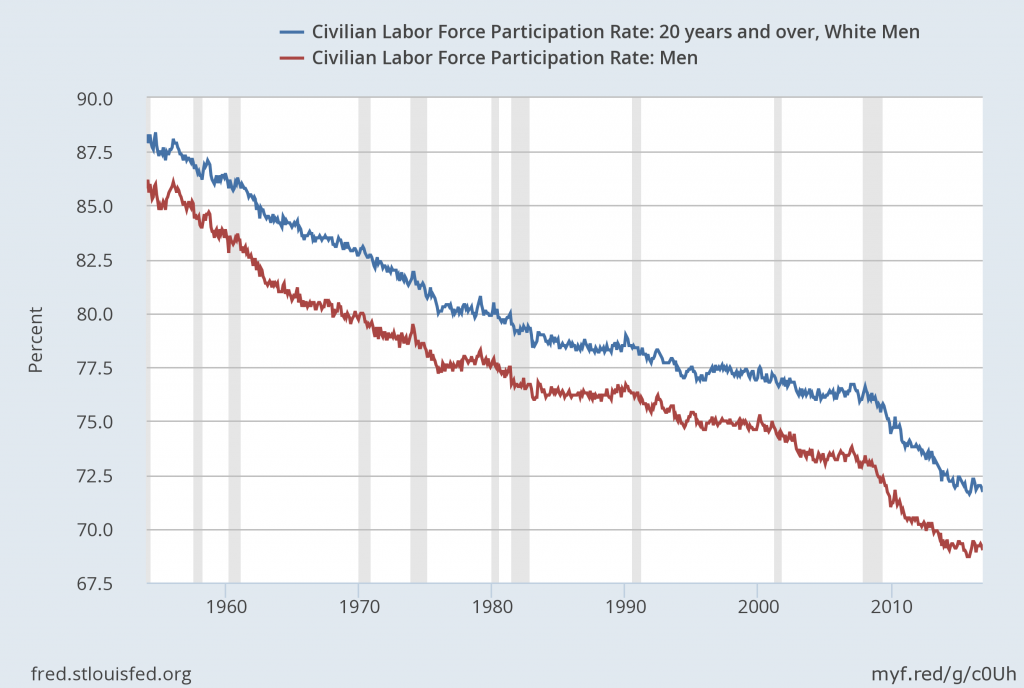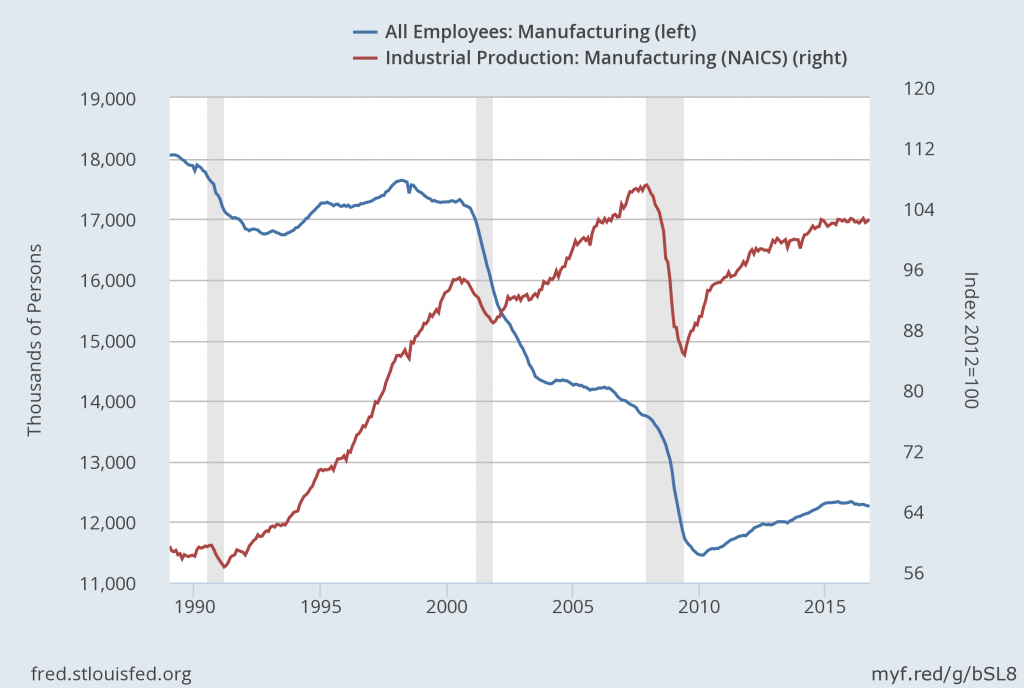An Economic Explanation for Why Donald Trump Won the 2016 Presidential Election
By Dr. Pierre Canac – With real GDP growing at 3.2% during the third quarter of 2016 while unemployment was running at 4.6% in November and 178,000 jobs were created during the month, we could have expected that the voters would have returned the incumbent party to the White House. However, it did not happen. It looks like many pundits were looking at the wrong statistics; instead, they should have paid more attention to labor force participation and employment in manufacturing which have both fallen.
Labor Force
Globalization has been accused of causing the loss of many jobs when in fact it has had a fairly limited impact on the overall number of jobs available. Figure 1 shows the U.S. Civilian Labor Force Participation rate for all men (in red) and white men (in blue). It can be seen that over time, progressively fewer workers in both categories have been participating in the labor force. Following the Great Recession of 2008-2009, the decline has accelerated and it is only since November 2015 that the participation rate has stabilized and in fact increased slightly between November 2015 and November 2016 from 68.7% to 69.0% for men and from 71.6% to 71.7% for white men. Evidence suggests that for the most part men who have withdrawn from the labor force want employment (not hands-outs); without jobs they have lost their status, pride and self-respect.
Unfortunately, they do not realize that the policies suggested by the candidate for whom many of them voted – mainly its proposed trade policies – are not going to help them since trade has little to do with the lack of job opportunities which has contributed to the declining labor force participation, a trend which started long ago as can be seen in figure 1. International trade patterns play only a small role as compared with technological change and robotisation. This view is supported by much research and becomes readily apparent when one considers that Europe is facing the same problem (further compounded by the austerity programs many of these countries have implemented). Populist and nationalist parties everywhere are exploiting the discontent among mainly white men by blaming trade, outsourcing and immigration – not the principal sources of the problem, but more politically appealing than the true major cause!
Figure 1

Manufacturing
Figure 2 tells a similar story. It shows that manufacturing output in the US has continued to increase even as employment in manufacturing has continuously fallen. The divergence between employment and manufacturing output is a clear reflection of the fact that productivity (output per worker) has improved dramatically, due mainly to improved technology and the fact that robots have replaced workers. The loss of “high-paying” manufacturing jobs is hardly due to foreign trade[1] and thus cannot be expected to return to the U.S. from abroad since it is the combination of technology and robots rather than foreign workers that explains the disappearance of the jobs American workers wish for. The jobs could only return if American workers accepted third-word country wages in order to be able to compete with robots.
Figure 2

Currently, no one has come up with an easy and effective solution guaranteed to create more jobs for the workers that have been displaced by technology and have been ignored by many economists and politicians; only two candidates (Donald Trump and Bernie Sanders) showed some sympathy for them, and one of them ended up winning the election. What are his chances of success? Not very large if you consider some of his initial moves!
Conclusion
The few hundred jobs (about 800 while 1300 are still going to Mexico) saved at Carrier may be good PR but are a drop in the bucket as between 150,000 and 200,000 jobs are created by the U.S. economy each month. For perspective, consider that according to Paul Krugman’s calculations, the U.S. would need deals equal to the Carrier agreement every week for 30 years to restore the number of jobs Obama created by the General Motors bailout alone. More importantly such favoritism can only weaken the rules and laws required for the smooth functioning of markets and the very capitalist system that has made the U.S. such a wealthy and great country. Conversely, ad hoc and crony capitalism such as the very costly Carrier deal, based on the whims of a political leader picking winners and losers is the sure road toward a failed state – or a banana republic – as it lacks transparency, decreases predictability, increases uncertainty and encourages bribery, lobbying and corruption. Jawboning businesses undermines the rule of law and is an abuse of presidential power; it is what Maduro does in Venezuela! Trump supporters argue that he should be taken seriously but not literally; however, the Carrier deal shows otherwise.
Pierre Canac, Ph.D.
Associate Professor of Economics
[1] However note that globalization and technology are interrelated. Foreign Direct Investment (FDI) and trade allow technology to spread while technological innovations (Information and Communication Technology) facilitate trade.